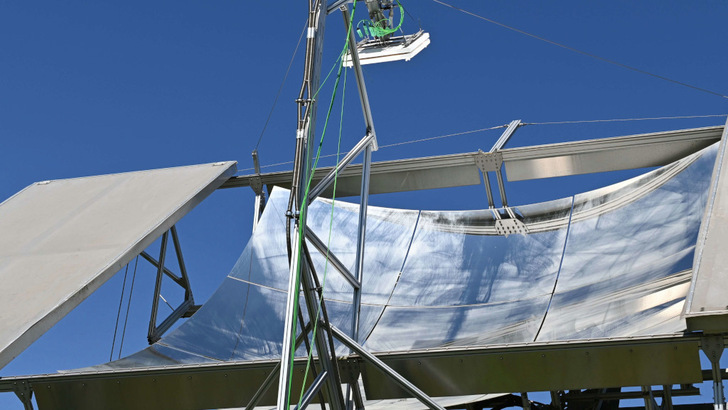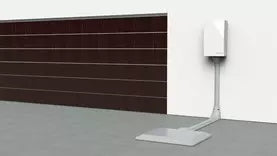https://www.pveurope.eu/hybrid-generators/solar-thermal-power-fraunhofer-ise-develops-new-concept-solar-thermal-tower-power
Fraunhofer ISE develops new concept for solar thermal tower power plants
Researchers at the Fraunhofer Institute for Solar Energy Systems (ISE) are using a completely new concept to drive up the efficiency of concentrated solar thermal power (CSP) tower power plants. To do this, they first changed the heat transfer medium used to transport the collected heat from the sun into the storage unit. Until now, molten salts have been used here. The disadvantage: these can only be used at temperatures of up to 600 degrees Celsius. If the temperature rises above that, the special thermal salts decompose.
New heat transfer medium for higher temperatures
However, the higher the temperature, the higher the efficiency of the entire power plant. For this reason, the researchers at Fraunhofer ISE in Freiburg have used a heat transfer medium consisting of solids that can reach operating temperatures of more than 1,000 degrees Celsius.
See also: Increasing the efficiency of solar thermal power plants
The heat transfer media are moved through the receiver and heated directly, similar to a carousel. The storage manufacturer Kraftblock from Sulzbach in the Saarland has developed new ceramic receiver elements for this purpose. These are heat-resistant and can store a lot of heat. In addition, they are produced in an environmentally friendly way from recycled material, which also lowers the price of the heat transfer material compared to expensive thermosalts.
The researchers have extensively tested and measured the ceramic material as a heat transfer medium. This allowed them to evaluate the behaviour of the material under highly concentrated solar radiation. "The next goal is to further develop the material of the receiver so that the energy is conducted deeper inside the body," says Gregor Bern, Group Leader Concentrating Systems and Technologies at Fraunhofer ISE.
Everything combined in one component
In the new receiver, they have also combined the solid-state heat carrier with the receiver of the solar radiation and the storage material in one component. This enables the Freiburg researchers to reduce the costs of building such power plants. In addition, they avoid the losses in heat transfer and the limitation of the flow of the heat transfer medium that are typical of conventional tubular receivers. As a result, the higher temperatures, which are better maintained even with fluctuating solar radiation, reduce the costs of solar thermal power generation.
Reducing heat losses
One problem with tower power plants is the losses due to the radiating heat. These occur at high temperatures and a strong concentration of sunlight and reduce efficiency. This is because the air around the receiver reaches temperatures above 600 degrees Celsius. The temperature of the ambient air, however, is typically in the range of 30 to 40 degrees Celsius. As it flows past the receiver, the cooler air absorbs its heat, which is then lost for power generation. Therefore, the researchers looked for a way to separate the different layers of air. The first idea was to use windows made of quartz glass. However, these do not exist in the required size.
Also interesting: Kenya: Solar drying and solar-powered ice production
That is why the researchers tested the idea of an air wall. This is formed by powerful nozzles at the opening of the receiver and separates the air around the receiver from the ambient air. "There have only been simulations of this solution so far. But the technology has never been demonstrated in the power plant sector before," explains Moritz Bitterling, a research associate in the Fraunhofer ISE project team.
Extensive measurement of the air wall
The Freiburg researchers have now changed that. They have set up a real-scale test station and equipped it with about 50 temperature sensors. They simulated the 600 degree hot receiver with heating elements. For the project, the industrial partner Luftwandtechnik specially designed an air wall system for the high-temperature application and installed it in the test stand. With this test, the researchers were then able to measure the radiation losses with and without the air wall and the heating power required to reach 600 degrees Celsius. Here they were also able to test how the operating parameters such as the angle of the air wall nozzles and the exit velocity of the air should be optimally designed. The result: with optimal setting of the operating parameters, the heat losses of the receiver due to radiation could be reduced by 30 per cent.
Measuring new mirrors
The Freiburg researchers also support the further development of the tower power plants themselves. Here, the trend is towards smaller units that are no longer equipped with the previous parabolic mirrors, but with so-called Stellio heliostats. These are pentagonal segmented mirrors that stand on a post and cast the sunlight onto the solar tower. Together with SBP Sonne, they want to reduce the costs of such systems by optimising the design of the pylon. This is to be adapted to the requirements of small tower power plants. The function of Fraunhofer ISE in this joint project is to measure the heliostats by means of 3D laser scanning and to test the procedure for rapid measurement of heliostats in the field. So far, the Freiburg researchers have used deflectrometric measurements of the mirror surfaces in the laboratory to analyse how they deform under certain loads.
Simulating the entire system
In the end, the researchers developed an overall concept from all these individual components. This consists of the receiver with solid-state heat carrier and air wall and the optimised Stellio heliostats, which were integrated into a solar thermal power plant. For this purpose, they also investigated which power plant process is best suited for coupling the individual newly developed components and how the heat can be transferred from the solids to the underlying process of a steam turbine power plant.
Did you miss this? New sensor independently measures degree of soiling of CSP plants
In the end, they modelled the entire system with a simulation tool, examined it and then evaluated it economically. In this way, the existing technical and economic models could be expanded and the optimal design and operation of a power plant with the new components could be determined. (su/mfo)



![[Dans les allées de BePositive] Systovi dévoile son prototype de panneau ultra-léger de 3 kg/m2](http://isolarparts.com/cdn/shop/articles/systovi-1.jpg?v=1679641666&width=870)
